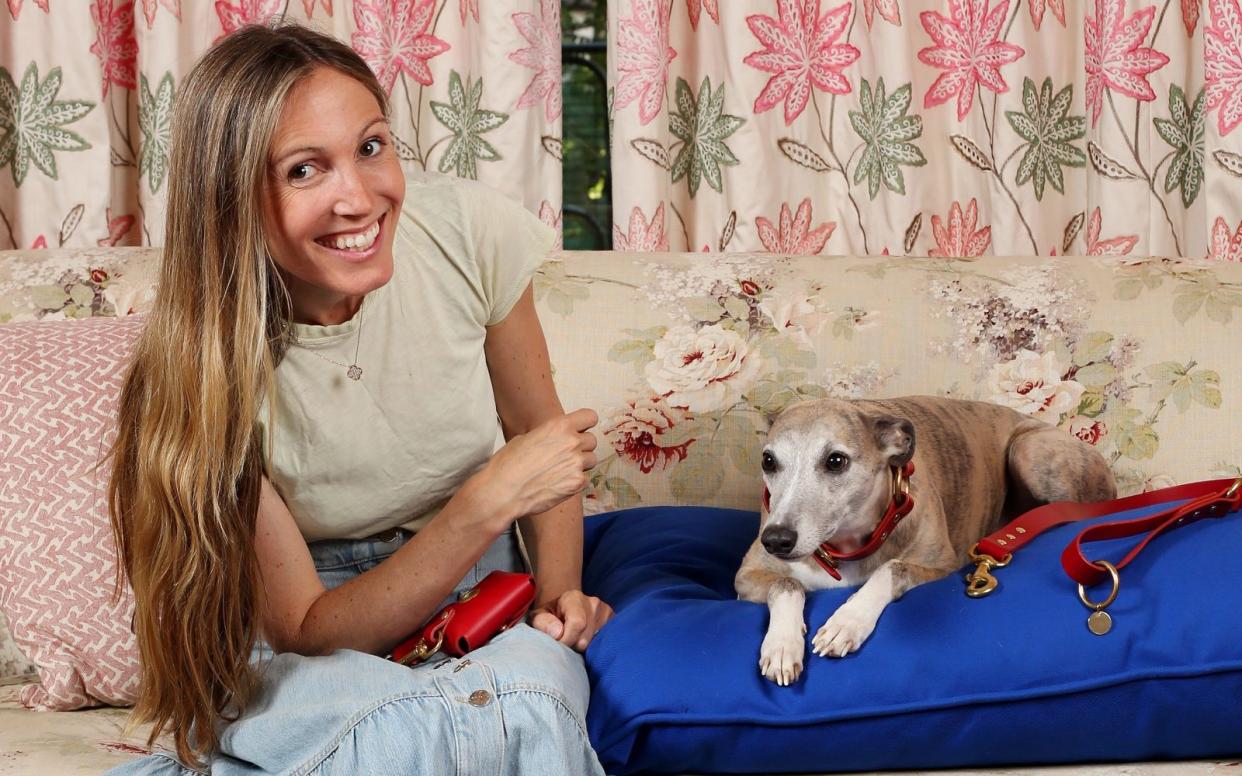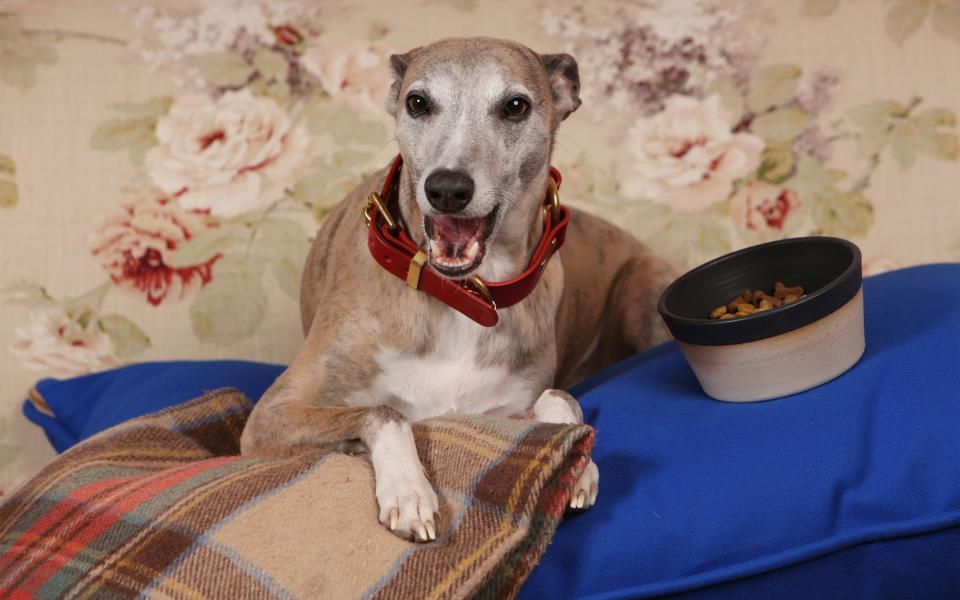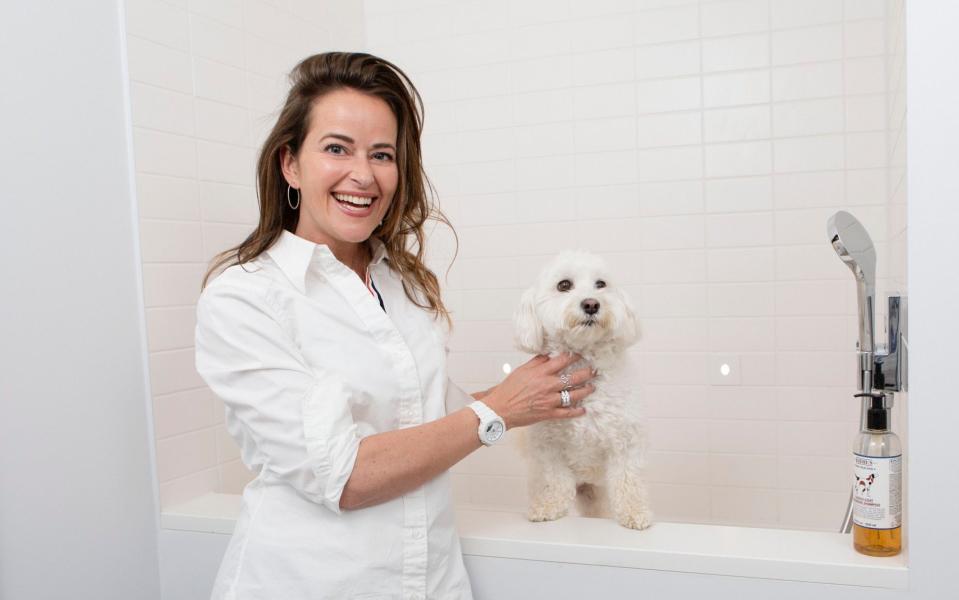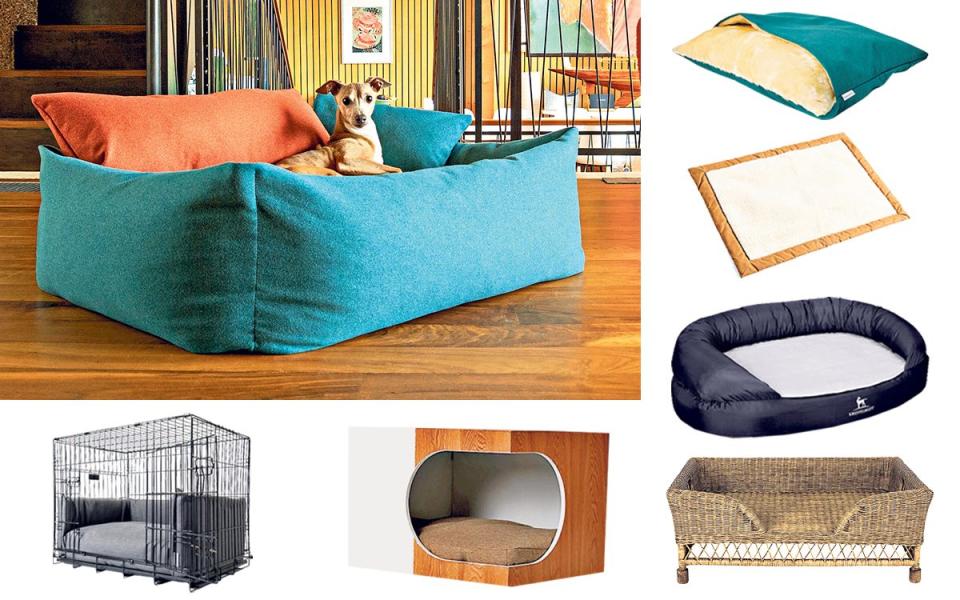How to design a beautiful space for your dog, and the best kit to buy

Raised rattan daybed or built-in cubby? Feather mattress or memory foam? And would he prefer a bath or a shower? Our dog Rudy is soon to get his own quarters in our new kitchen, and I’ve been so overwhelmed by dog-focused interior furnishings that I’ve even found myself browsing whippet-themed wallpapers. While dogs have always had a place in the British home – at the designer Anouska Hempel’s country house they have their own bedroom – they are now an intrinsic part of interior design considerations and architect’s plans.
“The way we live with our dogs has changed; they’re integrated into our lives and our living space,” explains Christine Chau, who has four Italian greyhounds and founded posh dog bed company, Charley Chau (charleychau.com). “When we first started in 2010, people were dismissive of our luxury beds, but now they have one in every room – they’ve become the norm.”
Post-lockdown there are more dogs in Britain than children under the age of 15 and Chau believes our devotion to them is only growing – indeed, studies show that millennials are more likely to be dog owners than parents or homeowners. “People have realised how much dogs bring to our emotional wellbeing as companions,” she says. “I keep hearing people telling me how grateful they are to their dog. They want them to feel comfortable and included – but equally they don’t want their house to look like a kennel.” Hence the flourishing “dogteriors” market where dog beds, blankets and accessories are designed to be tasteful, complimenting the interior design scheme of the home.
“You don’t lose your taste and sense of style when you get a dog,” confirms Rachael Field, co-founder of new fashion-led dog brand, Hound Dog, which is designed to be east London stylish rather than overtly “doggy”. “Your dog’s things are always out on display and so too is your dog – if the colours work well with the interior it’s pleasing.” Rather than twee bone prints and cutesy polka dots, her collection includes wax twill dogs’ work jackets in khaki, olive and tan, and hand-thrown glazed dog bowls on oak trays. “Everything is practical but also beautiful,” she says.

I intend Rudy’s cubby under the stairs to be the epitome of Le Chic de Chien (a term invented by luxury Parisian luggage-maker, Goyard, when it first brought out a range of dog accessories in the 19th century). It will be painted in a neutral yet warm clay colour with a simple spotlight on the ceiling and a zellige tiled floor. The only stumbling block is that it will need to contain a metal crate to contain Rudy when we go out and prevent him from shredding the new kitchen doors (he has form). Thankfully crates have come a long way – Charley Chau sells them with upholstered cushions and bolsters in tasteful colours, although more aesthetically-minded owners argue that they are unacceptably ugly.
Jo Amsel, whose family runs Hayfields Dog Hotel in Northamptonshire, used attractive wooden fencing to create a lockable area in her kitchen for her Italian greyhounds and dachshund. After toying with the idea of a bespoke metal door for Rudy’s den, I’m sticking with the crate: it’s largely concealed and Rudy feels secure in it. Plus, he’ll also have a bed in the new kitchen itself – his dove-grey, fur-lined mattress that we call his “envelope” – and he has his own fleece rug on his favourite sofa in the sitting room. I know, spoilt. But it makes sense, Chau assures me, for a dog to have multiple comfortable places around the house – as we move about the rooms, so too do they. Plus, they sleep for 12 to 14 hours a day.
The modern house hound, who enjoys free range of the sitting room, kitchen and potentially the bedroom (I’ve given up on trying to keep Rudy downstairs), has led to cleaning stations becoming the norm. Simone Suss, a dog-loving interior designer, has been asked to install so many that she’s come up with her own raised design. “Dog owners want efficient, accessible set- ups to enable them to wash and dry their dog after a muddy walk,” she says.
“Butler sinks with a handheld shower work well for bathing smaller breeds, but a raised shower with storage underneath is even more user-friendly. I tend to choose simple metro tiles and a soothing neutral paint palette to keep the room looking fresh.” Also popular in boot rooms are raised dog beds with air holes in them – if there’s airflow (and underfloor heating), a wet dog will dry more quickly, along with separate pet entrances to ensure muddy paws can be washed before they land on clean carpets. “Clients are inspired by what they see at the Pig and Soho Farmhouse and ask us to create similar spaces in their homes,” Suss says.

A bespoke pet shower will cost around £2,000 to build – a considerable outlay, given that I can wash Rudy perfectly well with a bucket of warm water and a brush by the back door. Yet Chau reminds me that our dogs are no longer just dogs. Their comfort is paramount, which why owners are also willing to spend eye-watering sums on orthopaedic mattresses and hand-carved oak beds with pillows. “Dogs are like people; they have different sleeping requirements at different stages of their lives,” she explains.
“Burrowing breeds such as dachshunds and terriers love to be covered up, as do short-haired breeds, such as whippets and Italian greyhounds, while dogs with heavier coats don’t like to be too warm. Some dogs like to stretch out; some like to rest their chins on the edge of the bed; older dogs need a firmer surface to support them when they stand up.” Along with duck feather mattresses, her company now sells anti-microbial memory foam mattress to protect older dogs from bruising themselves on the floor when they stand up, plus elegant raised frames in rattan. “A dog mattress is large – covered in the wrong fabric or plonked unceremoniously on the floor it will spoil the look of a room,” Chau says.
Another popular option is to create purpose-built cubbies for dogs in kitchen islands or cabinetry. Jo Ashwin of Hill Farm Furniture designs cabinetry for kitchens and boot rooms with dogs in mind, creating cosy nooks beneath work surfaces. “I was recently asked to design a whole designated dog room, with a bed with drawers underneath,” she says. The most popular colours for dog cabinetry are practical deep blues and greens, with muted greys, soft blues, fawns on any upholstery and terracotta or limestone on the floor, or ceramic tiles that resemble natural stone. Both Chau and Field have noticed, however, that pops are colour are creeping in to dogteriors: vibrant oranges, damson pinks and Yves Klein blue. “Changing the colours of your dog’s mattress covers can refresh the whole look of a room,” Chau says.
Where you feed your dog – and with what kind of bowl – is also a design opportunity, Field adds. She suggests earmarking a designated dining area for them, with a non-slip wooden tray and the kind of bowls you’d want to have on your own table, rather than the standard metal one that slides around the floor when they eat or drink. Her pointer eats out of a hand-thrown pot by Studio Ranj; Hempel’s dogs, meanwhile, eat their dog croutons and oxtail stew out of Goyard bowls, which are contained in a sturdy wood and leather tray.
No matter how highly you regard your dog, however, you should always consider the practicality of the homeware and soft furnishings you buy them. Amstel invested in a kitchen cabinet with built-in dog bed only for one of her dogs to chew it when they were bored. “You learn by your mistakes: in hindsight I’d have put brass edging on it, which would have been practical and also attractive,” she says. Field advises owners to choose mattress covers made of fabrics with high martindales (rub count) and strong stitching. “Dogs get dirty; they scratch things, spill things and chew things up – if you’re going to make things for dogs they need to have a decent lifespan as well as looking the part,” she says. Their mattresses therefore have scratch-resistant covers and she sells water bowls designed specifically for long-eared dogs. “Anyone with a spaniel knows how wet their ears can make the floor,” she says.
Rudy, I think, appreciates his new surroundings – he’s happy to curl up in his padded crate (the children call it his cell), but his preference is very definitely the vast rattan dog bed with scatter cushions that is currently positioned by the fire (and alas just on loan). Nina Campbell was right when she commented in the introduction to the revered coffee table book, At Home in the English Countryside: Designers and their Dogs, that dogs have an innate sense of taste. “My Theo not only always chooses the most comfortable chair or sofa, but also goes unerringly to what becomes a bestselling fabric when I am working in my studio,” she says.
A bed for every bark

Clockwise, from top left:
Worriers and nesters
Donut and bolster beds encourage dogs to curl up into a ball and the high sides and squashy centre offers comfort and protection. £240, charleychau.com
Burrowers and short-haired snugglers
The Charley Chau snuggle bed is a deep-filled mattress with faux-fur fleece cover for terriers, hounds and sight hounds to burrow beneath. From £95, charleychau.com
For those who take their owners to work
The Hound Dog sheepskin travel mat can be rolled up in a flash but has an orthopaedic fill for spine support. £65, hounddogcollective.com
Long in the tooth
Memory foam beds give extra support to ageing limbs, adapting to their shape and are a solid base when the dog stands up. From £91, knuffelwuff.co.uk
Sprawlers and hot dogs
Raised dog beds are an aesthetic choice for large breeds who require extra large mattresses. They also allow air circulation, keeping longer haired breeds cool. Rattan dog bed frame, £550, oka.com
Miniature breeds
Is it a table or is it a dog bed? DormiTablz is a mid-century inspired semi-enclosed wooden bed house, that also functions as a table. £229.99, purringpuppy.com
Runaways, chewers and agoraphobics
Crates don’t get more stylish than Charley Chau’s bumper-lined den with feather mattress. From £103.50 for the bedding, charleychau.com
Posh dogware

Clockwise from top left:
European oak tray with hand-thrown pot, from £120, hounddogcollective.com
Little snail dog toy, £18.50, mungoandmaud.com
Faux-fur dog blanket, from £80, charleychau.com
Pet food bin £129.95, Simplehuman, johnlewis.com
Designer dogs wallpaper, price on application, pierrefrey.com
Country walk-scented candle, £20, thestatelyhound.com
Pet bed larder cabinet, £1,995, coxandcox.co.uk


